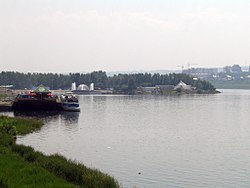
Angara is hampered by three major dams, hydroelectric plants, which have been built since 1950.
* Irkutsk Dam (Иркутская ГЭС), forming the Irkutsk Reservoir, which flooded the river valley from birth to Irkutsk, and slightly raises the water level in Lake Baikal.
* Bratsk dam forming the reservoir Bratsk.
* Ust-Ilimsk Dam (Усть-Илимская ГЭС) in Ust-Ilimsk forming Ust-Ilimsk tank.
* Boguchany Dam (Богучанская ГЭС) (under construction) to Kodinsk
Several villages along the Angara River and its tributaries (including the historic fort is Ilimsk Ilim), as well as a number of agricultural areas in the valley of the river, was flooded with these tanks. Because of its impact on the way of life of rural dwellers Angara valley, the dam has criticized a number of Soviet intellectuals, in particular, the writer Valentin Rasputin, Irkutsk, and his novel A Farewell to Matyora and its non-fiction book, Siberia, Siberia.
 The selenium yeast (Russian: Селенга) or Selenge (Mongolian: Сэлэнгэ гол, Сэлэнгэ мөрөн, Buryatia: Сэлэнгэ гол) is the largest river in Mongolia and Buryatia (Russia). Its Rivers and River are Ideriin Delgermörön. It flows into Lake Baikal, and has a length of 616 miles (992 km) (1024 km, according to other sources). The selenium yeast is the source of system-Yenisei Angara River. It carries 935 m³ / s of water in Lake Baikal, which account for nearly half the river flow and forms a delta when it reaches the lake (680 km ²).
The selenium yeast (Russian: Селенга) or Selenge (Mongolian: Сэлэнгэ гол, Сэлэнгэ мөрөн, Buryatia: Сэлэнгэ гол) is the largest river in Mongolia and Buryatia (Russia). Its Rivers and River are Ideriin Delgermörön. It flows into Lake Baikal, and has a length of 616 miles (992 km) (1024 km, according to other sources). The selenium yeast is the source of system-Yenisei Angara River. It carries 935 m³ / s of water in Lake Baikal, which account for nearly half the river flow and forms a delta when it reaches the lake (680 km ²).





